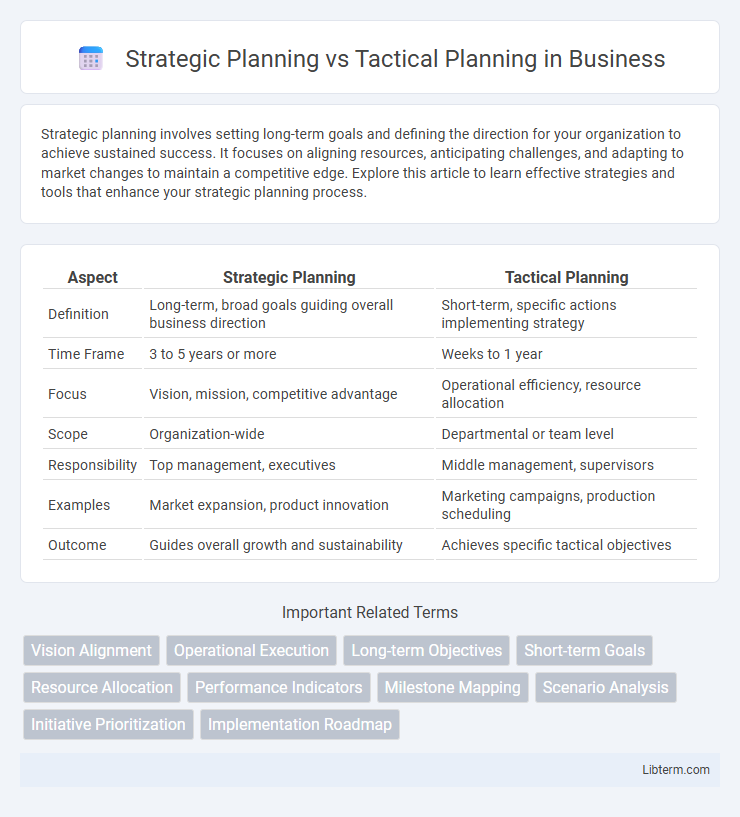Strategic planning involves setting long-term goals and defining the direction for your organization to achieve sustained success. It focuses on aligning resources, anticipating challenges, and adapting to market changes to maintain a competitive edge. Explore this article to learn effective strategies and tools that enhance your strategic planning process.
Table of Comparison
| Aspect | Strategic Planning | Tactical Planning |
|---|---|---|
| Definition | Long-term, broad goals guiding overall business direction | Short-term, specific actions implementing strategy |
| Time Frame | 3 to 5 years or more | Weeks to 1 year |
| Focus | Vision, mission, competitive advantage | Operational efficiency, resource allocation |
| Scope | Organization-wide | Departmental or team level |
| Responsibility | Top management, executives | Middle management, supervisors |
| Examples | Market expansion, product innovation | Marketing campaigns, production scheduling |
| Outcome | Guides overall growth and sustainability | Achieves specific tactical objectives |
Introduction to Strategic and Tactical Planning
Strategic planning involves defining an organization's long-term vision, goals, and overall direction to achieve sustainable growth and competitive advantage. Tactical planning translates these strategic objectives into specific, short-term actions and resource allocations to efficiently address immediate priorities and operational challenges. Both planning processes are essential for aligning activities across different organizational levels and ensuring coherent progress toward organizational success.
Defining Strategic Planning
Strategic planning involves setting long-term goals and determining the overall direction of an organization by analyzing internal and external environments, including market trends and competitive positioning. It focuses on defining the vision, mission, and high-level objectives that guide resource allocation and decision-making over several years. Unlike tactical planning, strategic planning emphasizes broad, future-oriented outcomes rather than immediate actions or short-term projects.
Defining Tactical Planning
Tactical planning translates strategic objectives into actionable short-term plans that direct day-to-day operations and resource allocation. It focuses on specific tasks, timelines, and responsibilities to achieve immediate goals within a defined scope. Effective tactical planning ensures alignment with broader strategic goals while addressing operational details and performance metrics.
Key Differences Between Strategic and Tactical Planning
Strategic planning defines an organization's long-term goals and overall vision, focusing on where the company wants to be in the next 3 to 5 years. Tactical planning breaks down these broad objectives into specific, short-term actions and processes aimed at achieving strategic goals within weeks or months. Key differences include the scope, with strategic planning having a broader, high-level perspective, and tactical planning emphasizing detailed execution and resource allocation.
Importance of Aligning Strategy and Tactics
Aligning strategic planning with tactical execution is essential for organizational success, ensuring long-term goals are effectively translated into actionable steps. Strategic planning sets the vision and priorities, while tactical planning focuses on the day-to-day activities that drive progress toward those objectives. Misalignment between these two levels can lead to resource wastage, inconsistent decision-making, and diminished overall performance.
Steps Involved in Strategic Planning
Strategic planning involves defining an organization's vision, setting long-term goals, and analyzing internal and external environments through SWOT analysis to identify opportunities and threats. The process includes formulating strategies to achieve objectives, allocating resources effectively, and establishing performance metrics for monitoring progress. This systematic approach ensures alignment between organizational mission and market dynamics, driving sustainable competitive advantage.
Steps Involved in Tactical Planning
Tactical planning involves specific actions and detailed steps to achieve short-term objectives aligned with broader strategic goals. The key steps include setting measurable targets, allocating resources effectively, developing operational procedures, assigning responsibilities to teams, and establishing timelines for task completion. Monitoring progress and making necessary adjustments ensure tactical plans stay on track to support the overall strategic plan.
Real-World Examples: Strategic vs Tactical Decisions
Strategic planning involves long-term goals such as a tech company deciding to enter a new global market by investing in R&D and partnerships, while tactical planning focuses on short-term actions like creating a marketing campaign or adjusting production schedules to support that expansion. For instance, a retail chain's strategic decision might be to increase their online presence over five years, whereas their tactical tactics include social media promotions and inventory logistics improvements each quarter. Companies blend both planning levels to ensure cohesive progress from vision to operational execution.
Common Challenges in Strategic and Tactical Planning
Common challenges in strategic and tactical planning include aligning organizational goals with available resources, managing uncertainties in market conditions, and maintaining clear communication across departments. Both planning types often face difficulties in adapting to rapidly changing environments while ensuring accountability and measurable outcomes. Overcoming these obstacles requires robust data analysis, flexible frameworks, and continuous monitoring to align execution with strategic objectives.
Best Practices for Integrating Strategic and Tactical Plans
Integrating strategic and tactical plans requires aligning long-term goals with short-term actions through clear communication and ongoing collaboration between leadership and operational teams. Best practices include establishing measurable objectives, prioritizing resources based on strategic importance, and using performance metrics to track progress and adjust tactics accordingly. Utilizing integrated planning tools and regular review cycles ensures agility and coherence between strategic vision and tactical execution.
Strategic Planning Infographic

 libterm.com
libterm.com